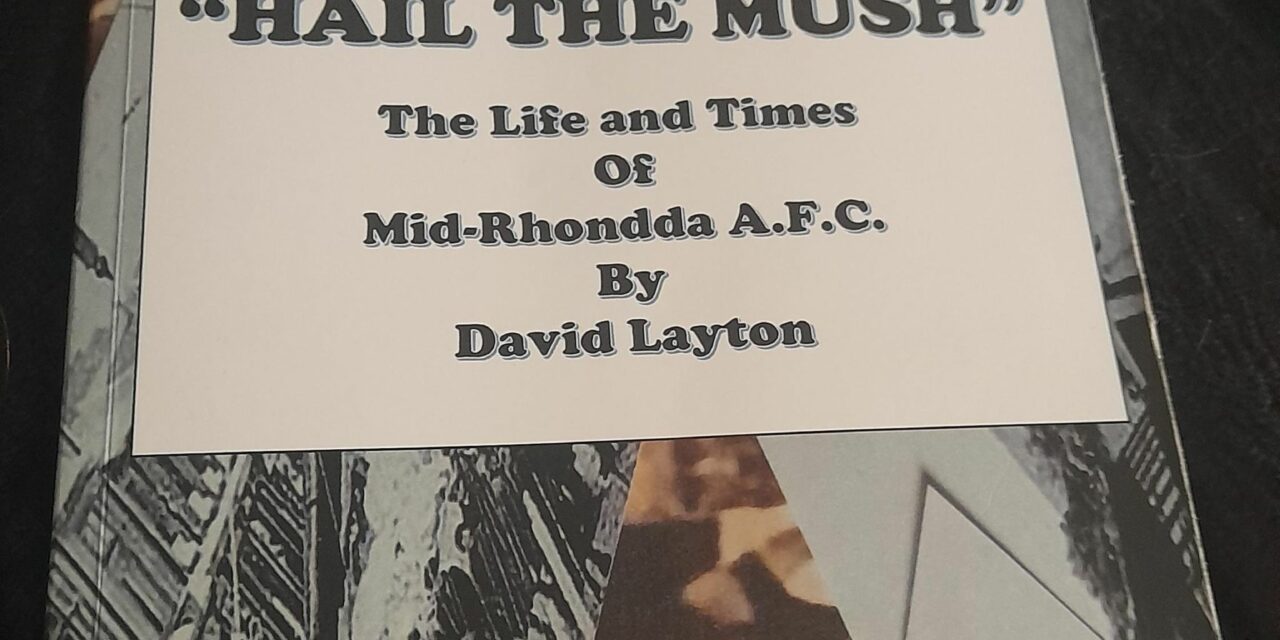By
Rob Jones
Hail The Mush: The Life and Times of Mid Rhondda A.F.C. by David Layton is a fine account of a period in the history of Tonypandy where a diverse and always changing group of folk tried but failed in achieving the ambitions of operating a functioning football league team. The years 1912-1928 has The Mid Rhondda Ground in the town host Southern League and Welsh League soccer with the ultimate aim to house a fully fledged professional side playing in the upper tiers of the English pyramid system.
As close as it got was an opportunity to enter the lower ranks of the football league structure but a change in that streamlining brought that dream to an end. At that juncture the playing squad was best equipped after a series of triumphs put them on a pedestal ready to transition to an elevated level. Players came from all over the UK with a seemingly top heavy selection of English and Scottish men while also a crop of Irish travelled into the Rhondda to wear the colours of a club that became known as ‘The Mush’ (as they had sprung up so quickly like ‘mushrooms’).
The strange thing is that despite the location of a growing sporting pedigree of personnel – footballers from within the community did not seem to make the grade and it was the late, great Dai Collier who broke that routine. Although, Haydn Price, one of the most noted managers in the club annals was also a Rhondda product. In the main it was the on field imports and names such as Jimmy Seed, Angus Seed, Jimmy Carmichael, Kenny Bain, Joe Bache plus a whole host of others that scored as fans favourites over a turbulent sixteen years.
During that period there was success on the pitch but sadly that glory did not allow for progress for a number of reasons. Divisional re-structuring put a block on entry to the old Southern league First Division as the Football League took on another format and The Mush were prevented from moving up to a new third rung of the ladder to the summit.
Perpetual financial hurdles and trying to match ever increasing outgoings with more meagre incomings was the ultimate mountain to climb and every time the club got near the cliff top, off they would fall. To add to which the usual politics which can darken all aspects of life seem to cloud the march of The Mush as it appeared that the wider authorities were not interested in a Tonypandy team aiming for the stars.
There were many factors that did not help the cause of The Mush. These integers included:
*World War One and its negative knock on effects.
*Poverty led by an unsettled workforce fighting for better pay and their rights.
*Lots of other football competitors in the valleys.
*The growth of Cardiff City FC in to a major force who won the FA Cup Final in 1927 which saw a number of Tonypandy folk drift away to watch an enhanced standard of soccer on the coast.
*Players getting poached for better salary options and also improved career opportunities, and that means leaving Tonypandy to join illustrious clubs such as Liverpool and Spurs (yes! That is true, scouts came from all over to run the roost over Rhondda based talent).
*Fans, who may sneak into the ground or watch from outside the ground did not add to the depleted coffers. Therefore, a diminished revenue did not assist a team that could attract multiple selections of spectators, including bumper attendances of 20,000. Those getting in for free became an issue as those characters were not in their ones or twos.
It is amazing to think that renowned clubs of the ilk of Cardiff City, Swansea Town, Stoke City, Southend United and Luton Town were in an initial division with a team from Tonypandy. These sides travelled to The Mid Rhondda Ground to play – and, in friendlies against strong line ups there were also 1919 triumphs over Nottingham Forest, Derby County and Portsmouth with a draw against Tottenham Hotspur plus a year later Aston Villa came to town.
Many other famous names from the round ball game took up their stalls against The Mush and the team were regarded as a recognised force that unfortunately could not develop. The author of this book offers an insight into the life and times of both the early 20th century and its impact upon a little soccer side trying to make a large sporting impact.
This review has only touched upon the peripheries of a story that has so much more to its contents. So please delve into this text as there are many powerful facts, quotes and insights into an era that may be distant but is still significant in the legacy of a famous part of not just Wales, but the globe.
Any historians will find interest in the moments of The Mush and nearly a century on since the demise there is a current campaign to retain the identity of The Mid Rhondda Ground, Tonypandy. The contemporary call is to instil some of this heritage documented as well as a great deal else in the tale of this green space and give the site a fresh perspective. For more details, go to: www.friendsofthemid.com
However, for now it is thanks to David Layton for taking an aspect of Pandy past and highlighting that it was not just a drop in the ocean. The Mush were far more than that! For those who do have an awareness of The Mush there is so much more to discover. I admit to being one of those who had a little knowledge but now thanks to this written release my understanding is far deeper.
The football facts appear to have a feel of fiction because of the highs and even more notable lows that are spread across a dramatic couple of decades. ‘Hail The Mush’, offers a means to explore and a never to be forgotten section of soccer legacy is in print for your entertainment…..but, this is far more than just an item of sporting literature. Please, go and check out the days of the magic and tragic ‘Mushrooms’.
Copies of the book are £10 and they are available from:
David Layton
11 Caemawr Gardens
Porth, CF39 9DB.
Telephone: 01443 681037
Mobile: 07894 983348



